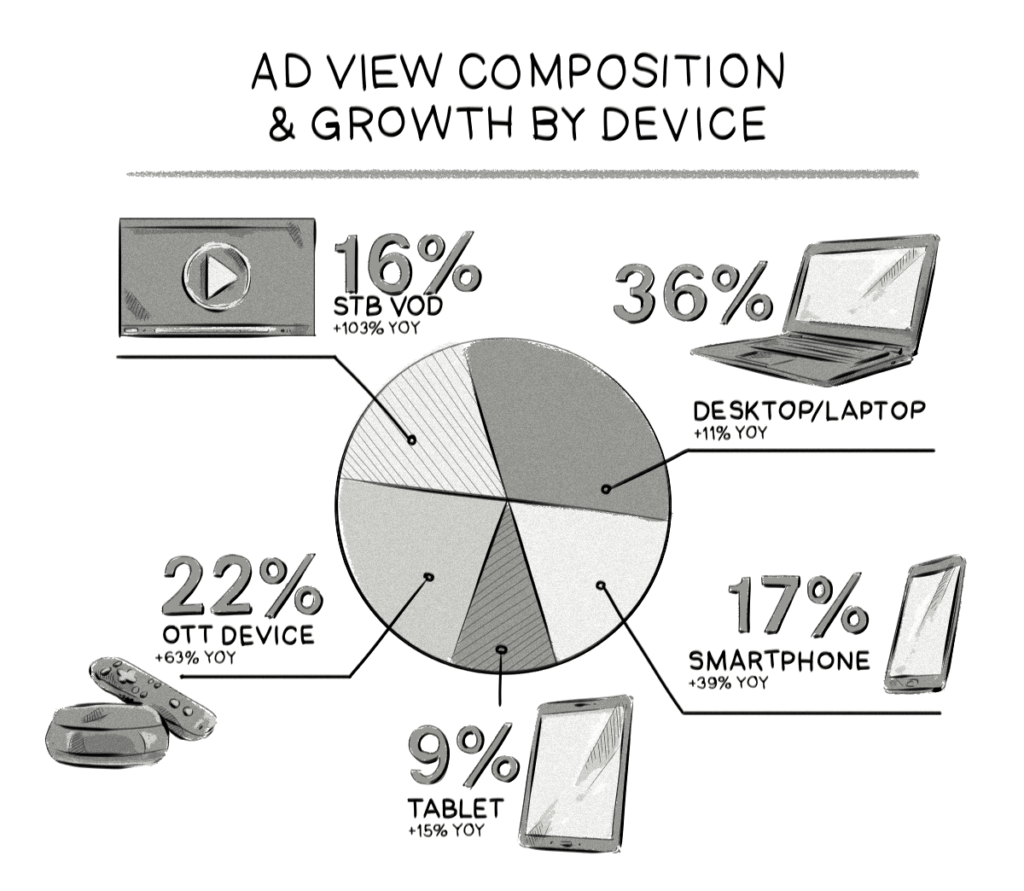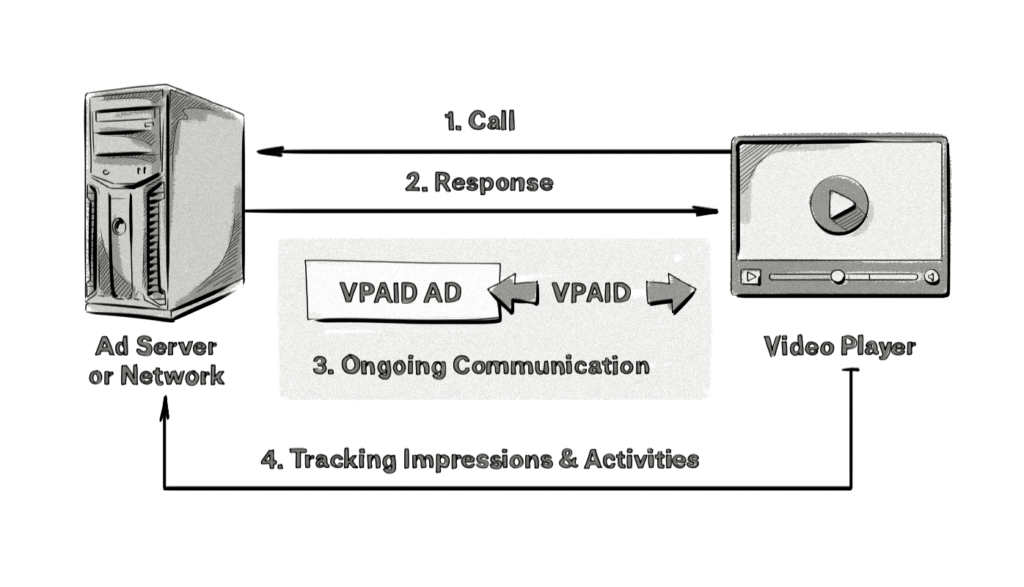Traditional terrestrial and cable TV are long past their heyday, trailing behind streaming media in reach, measurability and content quality. Video-ad views on OTT (over-the-top) devices grew 63% year over year in Q3 2016, and the trend is expected to continue, further crippling traditional TV advertising.
Traditional TV can offer advertisers a mere fraction of its original reach and appeal. Streaming content via the Internet is the new television, and the vast opportunities it offers advertisers may encourage more brands to move their ad dollars from traditional TV to more modern media. Before we call the winner and jump to conclusions, let’s track the roots of TV advertising and its slow evolution to advanced TV, towards a fully-fledged advertising medium.

Traditional TV
Terrestrial TV
Terrestrial television uses traditional, roof-mounted antennas that transmit analog signals, which by today’s standards doesn’t cut the mustard. Around 2010, analog terrestrial TV underwent a switchover to digital, which meant HD image quality and improved, more consistent signal distribution.
Cable
Cable TV originally emerged to allow reception in areas where using traditional TV antennas was challenged by terrain or environmental factors. Big “community antennas” were constructed, supplying signal to individual households using cables (hence cable TV).
Cable television was initially analog, and like in the case of terrestrial TV, the process of switching to digital cable started around the 2000s. The signal is transmitted through coaxial or fiber-optic cables directly to each household without the need for individual, external antennas. The same technology can also be used to transmit FM-radio programming, high-speed Internet, telephone and similar non-television services.
We Can Help You Build a Connected TV (CTV) Ad Platform
Our AdTech development teams can work with you to design, build, and maintain a custom-built connected TV (CTV) ad platform for any programmatic advertising channel.
Satellite
Satellite TV involves television programming with the use of communication satellites orbiting the globe. The signal is received via an outdoor satellite dish. A dedicated satellite receiver decodes the television program and displays it on a television set.
Satellite receivers and tuners can be either external set-top boxes or built into TV sets. Satellite television provides a wide range of channels and services, especially to areas where providing terrestrial television is impossible or difficult due to environmental factors.
Advanced TV
Advanced TV, the successor to traditional TV, is the newer, more modern way of delivering TV programming to households. The term was coined by the IAB and covers all forms of non-traditional television – TV that is not watched through a broadcast, cable or satellite connection. It includes Interactive TV, Connected TV, Smart TV, Over-the-Top (OTT) devices and Linear Addressable TV.
The primary difference and advantage of advanced over traditional TV is that it allows ads and other content to be targeted to specific households and be dynamically inserted into live programming.
The Different Types of Advanced TV Delivery and Advertising
When talking about programmatic/advanced TV, we are often dealing with terms like:
Connected TV: A Smart TV or television set connected to the Internet on its own or via OTT devices like blu-ray players, streaming boxes, sticks, or gaming consoles, enabling access to a variety of web-based content.
TV Everywhere: As the term implies, this allows consumers to watch live or on-demand content on any device other than a TV, anywhere. Most cable channels will require you to use your cable or satellite-login information to access content through their apps.
Video on Demand (VOD): Simply speaking, VOD is an umbrella term for content available for watching what you want to, when you want to. The content is controlled by and made available to a viewer after the official release date or original air date and time. VOD also encompasses content watched through OTT devices, mobile apps and video-streaming services. On-demand content is typically made available through set top boxes, OTT devices, mobile web, mobile apps and video-streaming services.
Confusing, right? Many types of advanced TV are closely related to one another and some of them overlap. To simplify things a bit and use just one term instead of five, the above types of advanced-TV devices are often referred to as OTT.
So let’s stick to OTT for the remaining part of the post.
OTT
The term OTT refers to all over-the-top devices or services that enable advanced TV and streaming digital content in households. This includes all internet-enabled streaming devices hooked up to the TV (not mobile phones and tablets):
- Streaming boxes (Apple TV, Amazon Fire TV, Android TV, Samsung Allshare Cast, etc.)
- HDMI “sticks” (small HDMI streaming devices like Chromecast, Roku or Amazon Fire TV Stick)
- Smart TVs (TVs offering built-in apps like Netflix or HBO Go)
- Game consoles
- DVR set-top boxes
- Internet-enabled smart blu-ray/DVD players
Simply put, OTT devices deliver content and advertising to your TV using streaming. The technology is expected to improve in coming months and falls under the advanced-TV category. Its benefits for advertisers will be twofold – the capabilities of programmatic ad-buying paired with the growing reach of streaming services.
With OTT ad revenue set to increase from 45% to 60% over the next decade, AdTech pioneers and early adopters of OTT advertising will reap its benefits in the near future.
How Are TV Ads Delivered?
Advanced TV allows advertisers to create campaigns based on behavioral data from each household. Advertisers can benefit by tapping into the treasure trove of viewership information – they know which ad, channel and program a viewer is watching, when and for how long. This is a far cry from traditional ad-buying.
In traditional TV ad-buying, Nielsen GRP data is used by marketers to purchase TV spots. The process is mostly manual and requires that the purchases are made directly through contacting the broadcaster prior to screening. Targeting is only “rough” and based on the programming and time of day.
Programmatic TV is advanced TV with ads purchased programmatically (in an automated way). Advanced TV can be purchased programmatically or non-programmatically through an ad network or directly from a streaming content provider, like Hulu, or a cable TV company, using data from set-to-box and other specialized data providers.
Addressable TV is characterized by better targeting. Different ads are displayed to different households watching a live TV program on the internet. Targeting individual households is possible through their behavioral, demographic or geographic data, which reduces wasted impressions. Satellite and broadcast television companies typically use linear addressable TV capabilities.
Advanced TV Targeting
Targeting to OTT/advanced TV devices is done at the household level (as opposed to the individual level, which is more common in digital advertising). The IAB distinguishes two methods of linking data to the viewing household:
High-Index Modeling: Viewership data helps decide which shows have the highest likelihood of being viewed by the desired audience (or household).
CrossDeviceGraph: Data pulled from other devices in the same household is used to create shared identifiers and target viewers. CrossDeviceGraph can associate all the devices and match them to a single household using one of the three methods: probabilistic, deterministic or modelling.
- The probabilistic method is based on a probability that two devices belong to the same household. This is possible by analyzing thousands of anonymous data points including device type, location data and time of day. The probability of the link is benchmarked, which gives an idea of the expected accuracy. Advanced TV-advertising platforms can dynamically choose between accuracy and scale.
- The deterministic method utilizes login data when a consumer uses the same account across a number of devices (e.g. when they log in to Netflix on their laptop and their PS4). This method is much more accurate than the probabilistic method, but the data is less available.
- The modelling method uses algorithms to build the audience via the look-alike model, which finds new audiences similar to your existing ones (i.e. your highest-paying customers). In look-alike modelling, the DMP or DSP analyzes the pre-defined samples of “best customers” and applies algorithms to known data to find profiles that best match the “seed” audience. It’s kind of like a game of Cluedo, except you are not looking for a killer which matches your limited data, but the audience.
We’ve written more extensively about the probabilistic and deterministic matching methods in another post on our blog.
Usually only a combination of all of these methods makes the data set valuable.
Protocols for Ad Delivery
The process of targeting and matching devices to one household is half the battle. Communicating with household devices to properly display the ads on the screen is a whole different challenge: there are separate technologies, screen resolutions, ad formats, compression methods and user-interaction capabilities.
To take care of communication with advanced TV devices, video ad-serving protocols like VAST, VPAID, VMAP, and MRAID are used. They provide information about which video ad to display to the user, where the video ad should be placed, how long it should run for, whether the user is able to skip the video ad and what the destination URL should be. We’ve written about VAST, VPAID, VMAP, and MRAID in another post on the Clearcode blog, but here’s a brief overview of the different versions of VAST, as well as the other types of video ad-serving protocols:
Video Ad-Serving Template (VAST)
- VAST 1.0 (legacy) released in 2009 and supported single media files – mainly MP4, 3GP, and MOV file formats. It was only designed for linear ads with basic event tracking.
- VAST 2.0 introduced support for media formats like Flash and JavaScript. It allowed for both linear (e.g. pre-roll) and non-linear (e.g. overlays) ads to be served, and included quartile and player event tracking. Newer versions (3.0 and 4.0) are available today, but most publishers are still using VAST 2.0.
- VAST 3.0, released in July 2012, supports five ad formats: linear, non-linear, skippable linear ads, linear ads with companion ads and a sequenced group of ads known as ad pods.

- VAST 4.0, released in January 2016, is the latest version of VAST with new key features and upgrades, including ad verification and viewability execution, ad categories, universal ad IDs, support for mezzanine files and server-side support for ad stitching (which also fools ad blockers). While VAST has gone a long way in helping advertisers serve video ads, it lacked user-interaction capabilities. VPAID was introduced to solve the problem.
Video Player Ad Interface Definition (VPAID)
- VPAID allows advertisers to serve rich, interactive ads to users and collect data about how they interact with their video ads. Currently, there are two versions of VPAID available: VPAID 1.0 and VPAID 2.0. Here is an example of VPAID in action:
The ad allows the user to interact with the video by clicking on different tabs to view more information and engage with different elements – fill in a subscription form, complete a survey, or even play a game. VPAID can be used independently, but it is often embedded into VAST.

The diagram above provides a simplified example of how a video ad unit and video player communicate using the VPAID protocol. Here’s what’s happening:
- Call: The video player sends an ad call to the video ad server.
- Response: The video ad server sends back a VAST XML, which contains a VPAID-compliant executable ad unit.
- Ongoing Communication: While the video ad is being served and displayed to the user, the video player and the video ad unit are in constant communication, with the video player receiving properties for the ad unit and the ad unit sending events to the video player.
- Tracking Impressions and Activities: The ad unit and the video player can send information, such as impression and activity data, to their respective ad servers.
VAST, VPAID… What’s Next?
Publishers are generally reluctant to relinquish control over video playback and user experience to VPAID, and because VPAID uses wrappers, publishers don’t always know where the ads are really coming from. As we’re writing these words, a replacement for VPAID is in the pipeline. Little is still known about it today, but IAB’s recent post reveals that VPAID, although loved for its flexibility and innovation, brings limited transparency and trust issues and will soon be put to rest.
This shows that advanced TV is not rid of its problems, and is really a work in progress.
Video Multiple Ad Playlist (VMAP)
VMAP (current version 1.0.1) allows content owners (the people making the videos) to describe the structure for ad-inventory insertion if they don’t control the video player themselves, as is the case with YouTube, for example.
Even though VAST 3.0 contains ad pods that allow ad slots to be inserted into videos, it doesn’t allow content owners to define the ad breaks or their timing.
Mobile Rich Media Ad Interface Definitions (MRAID)
MRAID essentially allows advertisers to display their rich-media video ads across all mobile devices in all kinds of apps.
As mobile devices run on different operating systems, and apps are built using different languages, MRAID eliminates the need to create different rich-media ads for all the different mobile devices and apps.
Final Words
Advanced TV advertising, even though it is still in its infancy, will shape the future of TV advertising. As more advertisers and agencies start to introduce programmatic TV into their strategies, the challenges currently troubling the industry will fade away, and opportunities will emerge.
We Can Help You Build a Connected TV (CTV) Ad Platform
Our AdTech development teams can work with you to design, build, and maintain a custom-built connected TV (CTV) ad platform for any programmatic advertising channel.








